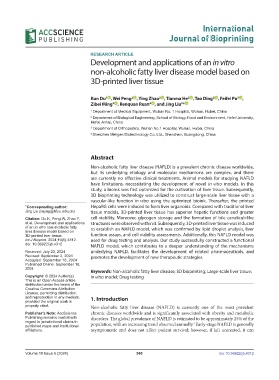Page 368 - IJB-10-6
P. 368
International
Journal of Bioprinting
RESEARCH ARTICLE
Development and applications of an in vitro
non-alcoholic fatty liver disease model based on
3D-printed liver tissue
Kun Du 1 id , Wei Peng 2 id , Ying Zhao 2 id , Tianma He 2 id , Tao Ding 2 id , Feifei Pu 3 id ,
Zibei Ming 2 id , Renquan Ruan 4 id , and Jing Liu *
2 id
1 Department of Medical Equipment, Wuhan No. 1 Hospital, Wuhan, Hubei, China
2 Department of Biological Engineering, School of Biology, Food and Environment, Hefei University,
Hefei, Anhui, China
3 Department of Orthopedics, Wuhan No.1 Hospital, Wuhan, Hubei, China
4 Shenzhen Mellgen Biotechnology Co. Ltd., Shenzhen, Guangdong, China
Abstract
Non-alcoholic fatty liver disease (NAFLD) is a prevalent chronic disease worldwide,
but its underlying etiology and molecular mechanisms are complex, and there
are currently no effective clinical treatments. Animal models for studying NAFLD
have limitations, necessitating the development of novel in vitro models. In this
study, a bioink was first optimized for the cultivation of liver tissue. Subsequently,
3D bioprinting technology was utilized to construct large-scale liver tissue with a
vascular-like function in vitro using the optimized bioink. Thereafter, the printed
*Corresponding author: HepaRG cells were induced to form liver organoids. Compared with traditional liver
Jing Liu (liujing@hfuu.edu.cn) tissue models, 3D-printed liver tissue has superior hepatic functions and greater
Citation: Du K, Peng W, Zhao Y, cell viability. Moreover, glycogen storage and the formation of bile canaliculi-like
et al. Development and applications structures were observed within it. Subsequently, 3D-printed liver tissue was induced
of an in vitro non-alcoholic fatty to establish an NAFLD model, which was confirmed by lipid droplet analysis, liver
liver disease model based on
3D-printed liver tissue. function assays, and cell viability assessments. Additionally, this NAFLD model was
Int J Bioprint. 2024;10(6):4312. used for drug testing and analysis. Our study successfully constructed a functional
doi: 10.36922/ijb.4312 NAFLD model, which contributes to a deeper understanding of the mechanisms
Received: July 23, 2024 underlying NAFLD, facilitates the development of related pharmaceuticals, and
Revised: September 2, 2024 promotes the development of new therapeutic strategies.
Accepted: September 18, 2024
Published Online: September 18,
2024
Keywords: Non-alcoholic fatty liver disease; 3D bioprinting; Large-scale liver tissue;
Copyright: © 2024 Author(s). In vitro model; Drug testing
This is an Open Access article
distributed under the terms of the
Creative Commons Attribution
License, permitting distribution,
and reproduction in any medium, 1. Introduction
provided the original work is
properly cited. Non-alcoholic fatty liver disease (NAFLD) is currently one of the most prevalent
Publisher’s Note: AccScience chronic diseases worldwide and is significantly associated with obesity and metabolic
Publishing remains neutral with disorders. The global prevalence of NAFLD is estimated to be approximately 25% of the
regard to jurisdictional claims in 1
published maps and institutional population, with an increasing trend observed annually. Early-stage NAFLD is generally
affiliations. asymptomatic and does not affect patient survival; however, if left untreated, it can
Volume 10 Issue 6 (2024) 360 doi: 10.36922/ijb.4312

